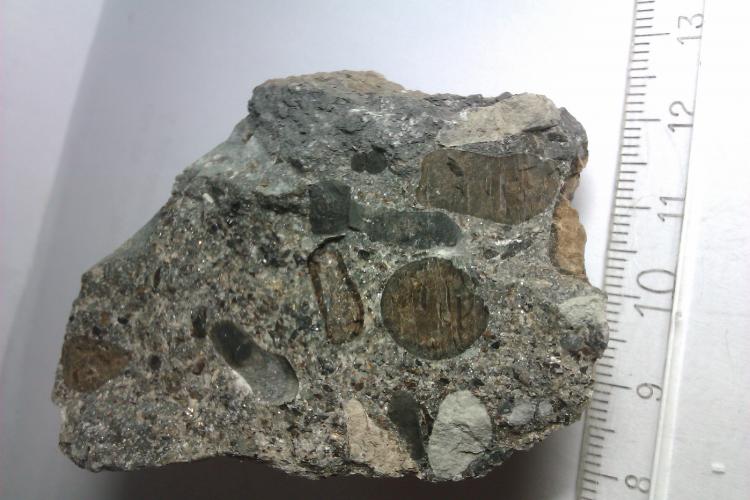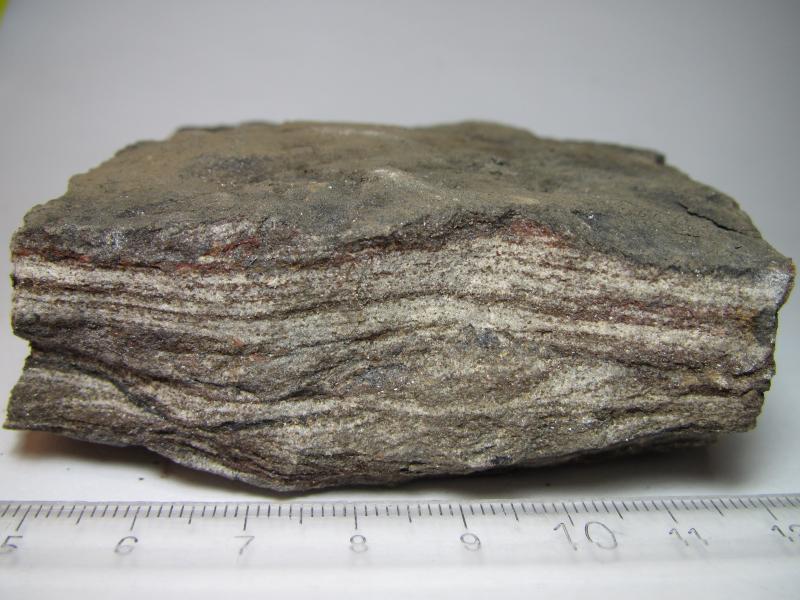| View previous topic :: View next topic |
| Author |
Message |
prcantos
Site Admin
Joined: 17 Apr 2012
Posts: 243
Location: Granada (Spain)



|
 Posted: Aug 06, 2012 13:01 Post subject: FMF Guide of Rocks - SEDIMENTARY ROCKS Posted: Aug 06, 2012 13:01 Post subject: FMF Guide of Rocks - SEDIMENTARY ROCKS |
|
|
I am really pleased to start this thread concerning rocks, after a similar and successful initiative at Spanish FMF Forum. I am so grateful to site admins for asking me to begin explaining what this guide consists of.
We are trying to collect photographs of rocks all around the world and as much information as possible about them: age, origin, description, composition... Rocks are closely related to minerals, as we usually find them forming rocks or growing on their surfaces and cavities. We intend to make a collective work where everybody can contribute and where expert opinions of geologists an petrologists is widely appreciated.
Photographs should show the macroscopical appearance of the specimen, though detailed pictures are usually advisable.
In order to keep the guide in order and reach and to guarantee a significant scientific level, you should proceed according to these rules:
1) If you are not sure about your rock specimen (mostly the name or the kind of rock), you should create before a new thread at "What is it? - Where is it from?" section giving the pictures and as much information as possible.
2) When the rock is properly identified, you can upload the photographs and the data in the corresponding section of FMF Rocks Guide (Igneous Rocks, Sedimentary Rocks or Metamorphic Rocks). If the rock do not fit a single group (e. g. some serpentinites, charnockites, some slates...), please choose the most accurate group in your opinion and explain it.
3) Use FMF fields at uploading photographs in this way:
*) MINERAL: write the whole name of the rock (name, varieties if known...)
*) LOCALITY: write the whole name of the location where the rocks was collected (include as many as possible: deposit, mine, geographical name, geological formation name, locality, region, country...). Please be precise at this point, your rock will be seen worldwide!
*) SIZE: in figures, or put some reference next to the specimen in the picture (a coin, a key, a pen...)
*) COMMENTS: write here the rest of the information, everything you consider to be interesting.
Of course further opinions and discussions are always welcome! Prosit!
FMF Guide of Sedimentary Rocks
Sedimentary rocks can be classified according to different criteria. A chemical classification contains these families:
[1] Siliceous and siliciclastic rocks: conglomerate, breccia, sandstone, siltstone, non-crystalline or microcrystalline forms of silica (opalo, chert, calcedonia...)
[2] Carbonate rocks: limestone, dolostone...
[3] Phosphatic rocks: phosphorus-rich rocks, e. g. phosphorite, phosphate nodules, bone beds, phosphatic mudrocks...
[4] Saline rocks: evaporites (halite, gypsum, anhidrite...)
[5] Iron-rich rocks: banded iron formations and similar.
[6] Manganese-rich rocks: nodules and layers in deep marine volcanic environments.
[7] Organich-rich rocks: varieties of coal, bituminous slates...
A genetic tipology may be:
[1] Clastic rocks: rocks containing particles which were placed in sedimentary basins, e. g. conglomerate, breccia, sandstones, lutites...
[2] Chemical sedimentary rocks: formed by inorganically precipitacion of minerals from supersaturated solutions, e. g. limestones, dolostones, evaporites...
[3] Organic sedimentary rocks: from incomplete decomposition of organic substances, e. g. coals, oil-petroleum, some bituminous rocks...
References
W. Maresch & O. Medenbach, Rocas, Barcelona (Spain) 1990.
F. Bastida, Geología, una visión moderna de las Ciencias de la Tierra (2 vols), Gijón (Spain) 2005.
_________________
Pablo Rodríguez Cantos
Λίθον˛ον απεδοκίμασαν˛οι οικοδομουντες |
|
| Back to top |
|
 |
prcantos
Site Admin
Joined: 17 Apr 2012
Posts: 243
Location: Granada (Spain)



|
 Posted: Aug 06, 2012 13:06 Post subject: Re: FMF Guide of Rocks - SEDIMENTARY ROCKS Posted: Aug 06, 2012 13:06 Post subject: Re: FMF Guide of Rocks - SEDIMENTARY ROCKS |
|
|
A sedimentary rock bearing fossils.
| Description: |
Fossiliferous limestone (bone bed)
Aust Cliff (Aust, South Gloucestershire, United Kingdom)
This upper-Triassic calcareous rock contains coprolites and bone and teeth fragments, as a kind of made-of-fossils conglomerate. |
|
| Viewed: |
56146 Time(s) |

|
| Description: |
Fossiliferous limestone (back side)
Aust Cliff (Aust, South Gloucestershire, United Kingdom)
Look at the black tooth in the upper part. |
|
| Viewed: |
56146 Time(s) |

|
| Description: |
Detail of the tooth
Aust Cliff (Aust, South Gloucestershire, United Kingdom)
20X |
|
| Viewed: |
56097 Time(s) |

|
_________________
Pablo Rodríguez Cantos
Λίθον˛ον απεδοκίμασαν˛οι οικοδομουντες |
|
| Back to top |
|
 |
prcantos
Site Admin
Joined: 17 Apr 2012
Posts: 243
Location: Granada (Spain)



|
 Posted: Aug 12, 2012 07:06 Post subject: Re: FMF Guide of Rocks - SEDIMENTARY ROCKS Posted: Aug 12, 2012 07:06 Post subject: Re: FMF Guide of Rocks - SEDIMENTARY ROCKS |
|
|
A glacial conglomerate (tillite).
| Description: |
Tillite (Lowestoft Till Glacial Conglomerate)
Thorpeness, Suffolk (United Kingdom)
Siliceous and calcareous clasts, with rounded or angular shapes and different sizes, were cemented in a marlstone matrix ca. more than half a million years ago. |
|
| Viewed: |
56039 Time(s) |

|
_________________
Pablo Rodríguez Cantos
Λίθον˛ον απεδοκίμασαν˛οι οικοδομουντες |
|
| Back to top |
|
 |
prcantos
Site Admin
Joined: 17 Apr 2012
Posts: 243
Location: Granada (Spain)



|
 Posted: Sep 19, 2012 11:34 Post subject: Re: FMF Guide of Rocks - SEDIMENTARY ROCKS Posted: Sep 19, 2012 11:34 Post subject: Re: FMF Guide of Rocks - SEDIMENTARY ROCKS |
|
|
Gypsum-rock from an evaporitic basin which was a Pliocen lake.
| Description: |
Gypsum-rock
Salazar (Baza, Granada, Spain) |
|
| Viewed: |
55758 Time(s) |

|
| Description: |
Gypsum-rock (back)
Salazar (Baza, Granada, Spain) |
|
| Viewed: |
55819 Time(s) |

|
_________________
Pablo Rodríguez Cantos
Λίθον˛ον απεδοκίμασαν˛οι οικοδομουντες |
|
| Back to top |
|
 |
Jordi Fabre
Overall coordinator of the Forum

Joined: 07 Aug 2006
Posts: 5080
Location: Barcelona



|
 Posted: Sep 24, 2012 05:24 Post subject: FMF Guide of Rocks - SEDIMENTARY ROCKS / Breccia Posted: Sep 24, 2012 05:24 Post subject: FMF Guide of Rocks - SEDIMENTARY ROCKS / Breccia |
|
|
Per Pablo request:
| prcantos wrote: | | Really beautiful rock. Why don't you put the specimen and the explanations in the FMF Guide of Rocks - SEDIMENTARY ROCKS ? |
I copied in this thread the Breccia that Geometerichachi published here and I also add the fine comments about it from Peter Megaw and Volkmar Stingl
| In https://www.mineral-forum.com/message-board/viewtopic.php?p=25844#25844 Peter Megaw wrote: |
This is a GREAT breccia...the cut face tells a wonderful story
The breccia is matrix supported with highly angular, even embayed fragments, in a layered matrix.
The matrix layering does not penetrate the fragments and in places layers appear to cut across other layers lying to their left.
Along the dark to lighter matrix zone the fragments appear to disturb/distort the layering.
The fragments get smaller to the right
overall it looks like UP is to the right.
The fragments look remarkably homogenous...but also are pitted and bleached, so I think that is a hydrothermal effect.
This looks to me like an internal cavern sediment dominated by "gossan" minerals at first, with fragments of corroded limestone dropped in, follwed by later layers of fine insoluble materials. The layers at the right appear to be more like Terra Rossa cavern fill than the dark iron-oxide layers on the left.
I think this came from a solution cavity lying below an oxidizing limestone replacement deposit of some kind. the cavity was dissolved by corrosive acid fluids derrived from oxidation of pyrite and sequentially filled with insoluble residue from the limestone and overlying orebody. occasionally chunks of altered limestone peeled off the back of the pocket and fell into the layered sediment fill
Good chance this was cut off the bottom of a nice wulfenite or mimetite specimen?
|
| In https://www.mineral-forum.com/message-board/viewtopic.php?p=25845#25845 Volkmar Stingl wrote: |
Peter, you got it! I think like you, this is a nice example of karst breccia like I have seen many before (in the Chinese karst regions, but also in the Upper Carboniferous/Early Permian karst of the Eastern Alps, and others). I like your explanation, it contains all details... (but to make it sure, you finally need the outcrop information).
Volkmar
|
| Description: |
Breccia
West US
Penny to scale |
|
| Viewed: |
55627 Time(s) |

|
| Description: |
Breccia
West US
Penny to scale |
|
| Viewed: |
55725 Time(s) |

|
|
|
| Back to top |
|
 |
prcantos
Site Admin
Joined: 17 Apr 2012
Posts: 243
Location: Granada (Spain)



|
 Posted: Dec 11, 2013 17:45 Post subject: Re: FMF Guide of Rocks - SEDIMENTARY ROCKS Posted: Dec 11, 2013 17:45 Post subject: Re: FMF Guide of Rocks - SEDIMENTARY ROCKS |
|
|
Siltstone is a consolidated detritic sedimentary rock with grain size between 0.002 (clays, or lutites, or pelites) and 0.063 mm. (sand, or psammites). Quartz and clays minerals are the main components, there may be many different accesories: mica, oxides, zeolites, calcite, dolomite, gypsum... It is often associated to clays, but there is a noticeable difference: siltstone has a rough touch while clays have a soft or greasy touch.
| Description: |
Siltstone
Huddersfield, West Yorkshire, England, United Kingdom
7'5 x 3 cm. (front) x 7 cm. |
|
| Viewed: |
52185 Time(s) |

|
_________________
Pablo Rodríguez Cantos
Λίθον˛ον απεδοκίμασαν˛οι οικοδομουντες |
|
| Back to top |
|
 |
|





